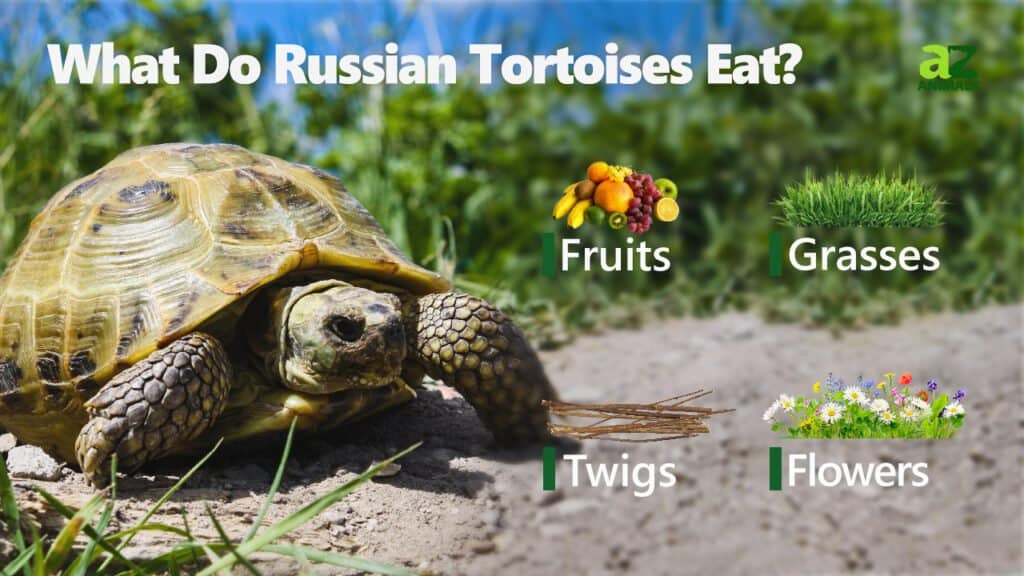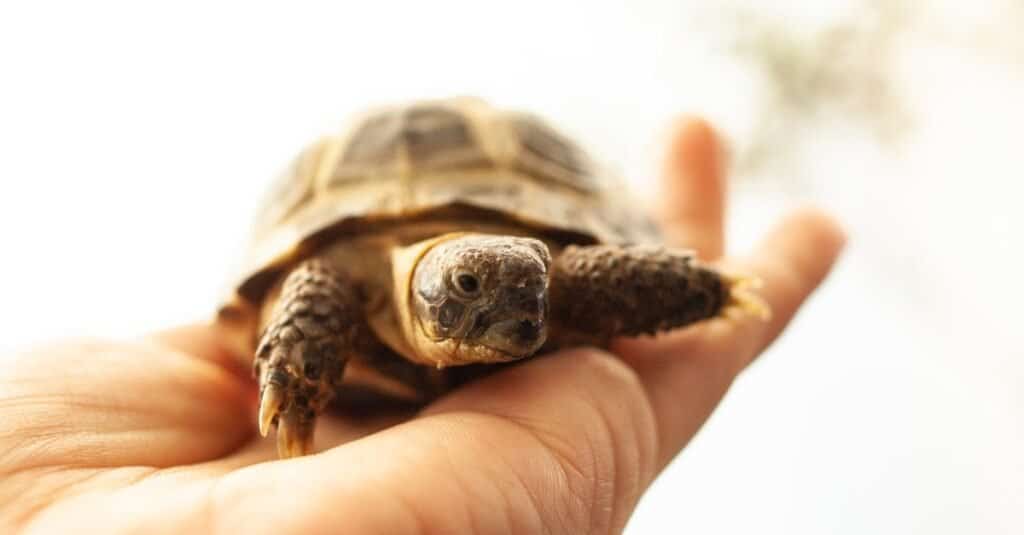The Russian tortoise, Agrionemys horsfieldii, is a small tortoise species. Its scientific name was done to honor Thomas Horsfield, a 19th-century American naturalist, and physician. Unlike many other tortoise species, the Russian tortoise is quite small. It will only ever grow to be only six to ten inches long. Although they are known as Russian tortoises, they can be found in many places other than Russia. They can be found in most of Asia and the Middle East.
But, what really makes this tiny tortoise so popular is its extremely sociable demeanor! Since they are so adorable, friendly, and small, they make for a great first exotic pet.
Curious to find out more about this friendly tortoise? Ever wondered what Russian tortoises eat? We’ve got all that information and more.
What Do Russian Tortoises Eat?

Russian tortoises eat a diet that consists of grasses, twigs, flowers, and other foods. They are predominately classified as herbivores. Their natural diet consists of high fiber, low protein, and rich sources of calcium. Russian tortoises never eat meat or insects in the wild, and these food sources should be avoided if they are kept as a pet.
Here’s a list of the foods Russian tortoises commonly eat:
- Collards (type of cabbage)
- Dandelion greens
- Kale
- Mustard greens
- Turnip greens
- Dandelion
- Edible flowers
- Hibiscus (flowers and leaves)
- Chia
For pet owners, be sure to avoid giving your turtle carbohydrates, and nutrient-poor foods like iceberg lettuce. Fruit is another item to avoid overfeeding your turtle with since it might cause parasite outbreaks. Most tortoises also can’t handle the high acid and sugar content of fruits.
Do Russian Tortoises Eat Every Day?
Tortoises that are not kept outdoors frequently tend to overindulge in food when presented with the opportunity, which means it is vital to practice controlled food portions. A useful guideline is to allow them to feed for 30 minutes each day.
Additionally, it is advisable to administer calcium and multivitamin supplements once a week.
Further, for hatchlings and young tortoises, provide daily meals, or split the daily portion into two, feeding them in the morning and afternoon. Adult tortoises, on the other hand, can be fed daily, or you have the option to skip one day of feeding each week.
What Do Baby Russian Tortoises Eat?
Baby Russian tortoises eat the same diverse diet of edible leaves, weeds, greens, and flowers as adults do. To ensure that they develop and stay healthy, special care should be taken to offer the best nourishment possible. When kept as a pet, offer a wide variety of greens and approved foods in order to avoid “overdosing” your tortoise on specific foods.
How Do Russian Tortoises Find Their Food?
Tortoises are classified as grazers, which means they roam from one location to another while consuming various foods. The majority of their natural diet will be determined by where they live. The Russian tortoise is considered a Mediterranean tortoise. Mediterranean tortoises can be found in grasslands where they mainly graze on shrubs and succulents. In the wild, these tortoises would be seen grazing on grasses, succulents, and stems.
However, these days, most Russian tortoises are kept as pets. In that case, you can still recreate the experience of grazing for them. If they’re placed outside in a backyard, they are content to munch on the grass that is available to them. You can even place different flowers and leafy greens on the ground and allow them to find these goodies themselves.
How Much Do Russian Tortoises Eat?

Pet Russian tortoises often overeat when given the chance.
©KOTORICHIKAPHOTO/Shutterstock.com
Russian tortoises are native to parts of the world that are barren with low rainfall. They must travel far and wide on a daily basis to locate enough food for the day. Russian tortoises are hardwired to explore and eat. This is why so many pet Russian tortoises are known for having a hearty appetite as they don’t always know when to stop.
Let your pet tortoise eat as much food as it can consume in 20 minutes once per day. To avoid food spoilage, remove any uneaten food after 20 minutes. Russian tortoises can graze freely outside and be fed tiny amounts of extra food on a regular basis. In an enclosure without weeds or flowers, fresh hay makes an excellent grazing option.
Does The Russian Tortoise Have Any Natural Predators?

Male Russian tortoises are actually smaller in size compared to females.
©Kirill Skorobogatko/Shutterstock.com
Since Russian tortoises are incredibly popular pets, it provides them with protection from many natural predators. In the wild, Russian tortoises are vulnerable to reptiles, such as lizards and snakes, as well as birds. Animals such as dogs, coyotes, skunks, possums, and raccoons can all attack vulnerable tortoises in captivity when housed outside.
Even if you keep your Russian tortoise in the house with a friendly dog, they may pose a threat without meaning to be one. Your dog may be incredibly kind and gentle to everyone. However, because Russian tortoises are a smaller kind of turtle, your favorite dog may hurt them. The dog may believe he is doing nothing but playing. Or maybe he thinks the tortoise is a snack. In any case, it’s critical to keep canines away from the pet tortoise. Repairing a Russian tortoise’s shell after a dog attack might cost hundreds of dollars in vet fees.
How Does the Russian Tortoise Protect Themselves from Predators?
Tortoises, while being a slower-moving animal, have lots of strategies to protect themselves against predators.
Some of these include:
- Hard Shell: Tortoises have a tough exterior shell that can discourage predators. They can retract their limbs, legs, and heads within their shell to defend themselves from predators. It isn’t always the ideal form of defense because some animals use their hands to pull the legs, but it is effective against predators who aren’t as determined or hungry.
- Pointed Beak: Tortoises have a hard, pointed, beak-like mouth that they use for feeding, but it may also be used to defend against attackers. The beak on Russian tortoises is not large, as the tortoise itself is not large, but it can prevent smaller animals from attacking.
- Digging Tunnels: Tortoises have the ability to burrow. This isn’t always helpful if a predator is approaching and the tortoise is sunbathing in the sun in the middle of the day. However, at night, when many enemies are awake, the Russian tortoise will most likely be resting in a burrow where they can’t easily get to them. The burrows are also present during the day to allow for a rapid escape if a predator appears out of nowhere.
The photo featured at the top of this post is © Elena M. Tarasova/Shutterstock.com
Thank you for reading! Have some feedback for us? Contact the AZ Animals editorial team.






